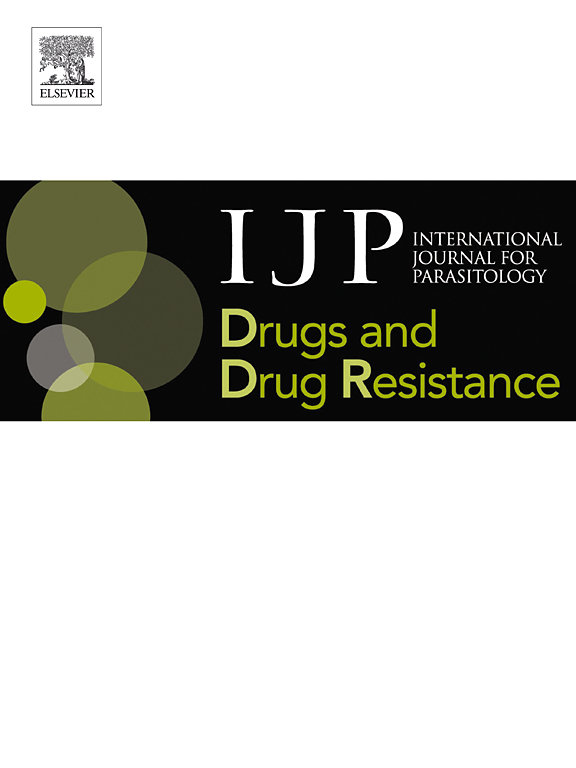Investigation of risk factors associated with Ancylostoma spp. infection and the benzimidazole F167Y resistance marker polymorphism in dogs from the United States
IF 3.4
2区 医学
Q1 PARASITOLOGY
International Journal for Parasitology: Drugs and Drug Resistance
Pub Date : 2025-01-31
DOI:10.1016/j.ijpddr.2025.100584
引用次数: 0
Abstract
Ancylostoma caninum is the most significant intestinal nematode parasite of dogs. We acquired fecal surveillance data from a large population of dogs in the United States (US). A diagnostic test using real-time PCR (qPCR) for Ancylostoma spp. and allele-specific qPCR detecting the SNP F167Y in the isotype 1 of the Beta-tubulin gene, was used in 885,424 randomized canine fecal samples collected between March 2022 and December 2023. Overall, Ancylostoma spp. had a prevalence of 1.76% (15,537/885,424), with the highest in the South 3.73% (10,747/287,576), and the lowest in the West 0.45% (632/140,282). Within the subset of Ancylostoma spp.-detected dogs used for further analysis, the F167Y SNP had an overall prevalence of 14.44% with the highest in the West and the lowest in the Midwest (10.76%). The greyhound exhibited a higher prevalence of Ancylostoma spp. infections (17.03%) and a higher prevalence of the F167Y polymorphism (33.6%) compared to non-greyhounds (13.7% and 2.08%), respectively, but were not associated with the highest risk for the F167Y polymorphism. Sex did not influence hookworm infection nor F167Y polymorphism prevalence. Intact dogs had a prevalence of hookworm infection and F167Y polymorphism of 3.88% and 15.66%, respectively. Puppies showed increased prevalence of hookworms (3.70%) and the F167Y SNP (17.1%). Greyhounds, bluetick coonhounds, and boerboels had the highest relative risks for hookworm infection, while Cavalier King Charles spaniels, Havanese, and shiba inus had the lowest. The top and bottom three with the highest and lowest RR for the F167Y SNP were the old English sheepdog, American foxhound, and toy poodle Toy, and shih tzu, Maltese, and Australian cattle dogs, respectively. This study highlights the value of an accessible diagnostic qPCR test with fast turnaround in unraveling the molecular epidemiology of hookworms and benzimidazole resistance, as well as explore potentially important risk factorsin dogs with routine veterinary care.

美国犬钩虫感染相关危险因素及苯并咪唑F167Y耐药标记多态性调查
犬钩虫(Ancylostoma caninum)是犬最重要的肠道线虫寄生虫。我们获得了美国大量犬类的粪便监测数据。对2022年3月至2023年12月期间随机收集的885,424份犬粪便样本进行了实时荧光定量PCR (real-time PCR, qPCR)和等位基因特异性qPCR检测,检测β -微管蛋白基因同型1的SNP F167Y。总体上,蜱虫患病率为1.76%(15,537/885,424),其中南部最高(3.73%)(10,747/287,576),西部最低(0.45%)(632/140,282)。在用于进一步分析的anylostoma spp检测犬的亚群中,F167Y SNP的总体患病率为14.44%,西部最高,中西部最低(10.76%)。与非灰狗(分别为13.7%和2.08%)相比,灰狗的弓形虫感染率(17.03%)和F167Y多态性的患病率(33.6%)更高,但与F167Y多态性的最高风险无关。性别对钩虫感染和F167Y多态性患病率没有影响。完整犬钩虫感染率和F167Y多态性分别为3.88%和15.66%。幼犬的钩虫患病率增加(3.70%),F167Y SNP患病率增加(17.1%)。灰狗、蓝tick猎犬和boerboels感染钩虫的相对风险最高,而骑士国王查尔斯猎犬、哈瓦那猎犬和柴犬的相对风险最低。F167Y SNP RR最高和最低的前三位分别是老英国牧羊犬、美国猎狐犬和玩具贵宾犬toy,以及西施犬、马耳他犬和澳大利亚牛犬。本研究强调了一种易于获得的快速诊断qPCR测试在揭示钩虫分子流行病学和苯并咪唑耐药性方面的价值,以及探索常规兽医护理犬的潜在重要风险因素。
本文章由计算机程序翻译,如有差异,请以英文原文为准。
求助全文
约1分钟内获得全文
求助全文
来源期刊

International Journal for Parasitology: Drugs and Drug Resistance
PARASITOLOGY-PHARMACOLOGY & PHARMACY
CiteScore
7.90
自引率
7.50%
发文量
31
审稿时长
48 days
期刊介绍:
The International Journal for Parasitology – Drugs and Drug Resistance is one of a series of specialist, open access journals launched by the International Journal for Parasitology. It publishes the results of original research in the area of anti-parasite drug identification, development and evaluation, and parasite drug resistance. The journal also covers research into natural products as anti-parasitic agents, and bioactive parasite products. Studies can be aimed at unicellular or multicellular parasites of human or veterinary importance.
 求助内容:
求助内容: 应助结果提醒方式:
应助结果提醒方式:


